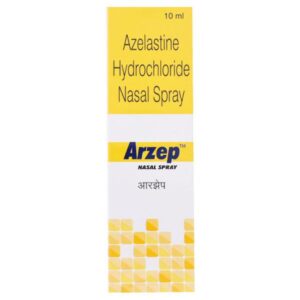BENZALKONIUM CHLORIDE + AZELASTINE
Benzalkonium Chloride: Benzalkonium Chloride is a medication primarily used as a disinfectant and antiseptic. It belongs to the class of compounds known as quaternary ammonium compounds. It is commonly found in various household products such as hand sanitizers, disinfectants, and eye drops.
The main mechanism of action of Benzalkonium Chloride is its ability to disrupt the lipid layer of bacterial cell membranes, leading to the leakage of cellular contents and ultimately resulting in the death of bacteria. It is effective against a broad spectrum of bacteria, viruses, and fungi.
The specific dose of Benzalkonium Chloride can vary depending on the product and intended use. For example, in hand sanitizers, solutions containing 0.1% to 0.13% Benzalkonium Chloride are commonly used.
As for side effects, Benzalkonium Chloride is generally safe when used as directed. However, some individuals may experience skin irritation or allergic reactions, especially in those with sensitive skin. Prolonged or repeated exposure to high concentrations of Benzalkonium Chloride can cause skin dryness, redness, or burning sensation.
It is important to note that Benzalkonium Chloride should not be ingested or applied to open wounds as it can be toxic if used improperly. As always, it is essential to follow the instructions provided by the specific product and consult a healthcare professional if any adverse effects occur.
Azelastine: Azelastine is an antihistamine drug that is primarily used to treat symptoms of allergic rhinitis, including sneezing, itching, runny or stuffy nose, and itchy or watery eyes. It comes in the form of a nasal spray and is available by prescription.
The mechanism of action of Azelastine involves blocking the release of histamine, a chemical that contributes to allergic reactions. By doing so, it helps alleviate allergic symptoms. Azelastine also possesses some anti-inflammatory properties, which can further reduce nasal congestion and inflammation.
The recommended dose of Azelastine nasal spray for adults and children above the age of 12 is usually one or two sprays in each nostril twice a day. However, the exact dosage may vary depending on the individual’s condition and the doctor’s instructions. It is important to follow the prescribed dose and not exceed the recommended amount.
Like any medication, Azelastine may cause side effects. Common side effects include bitter taste, nasal irritation or burning, headache, drowsiness, and nasal bleeding. If these side effects become bothersome or persist, it is advisable to consult a healthcare professional. In rare cases, more serious side effects such as allergic reactions, irregular heartbeat, or breathing difficulties may occur. If any of these severe side effects occur, immediate medical attention is required.
It is essential to inform the healthcare provider about any pre-existing conditions, ongoing medications, or allergies before starting Azelastine. This will help ensure the safe and effective use of the medication.

